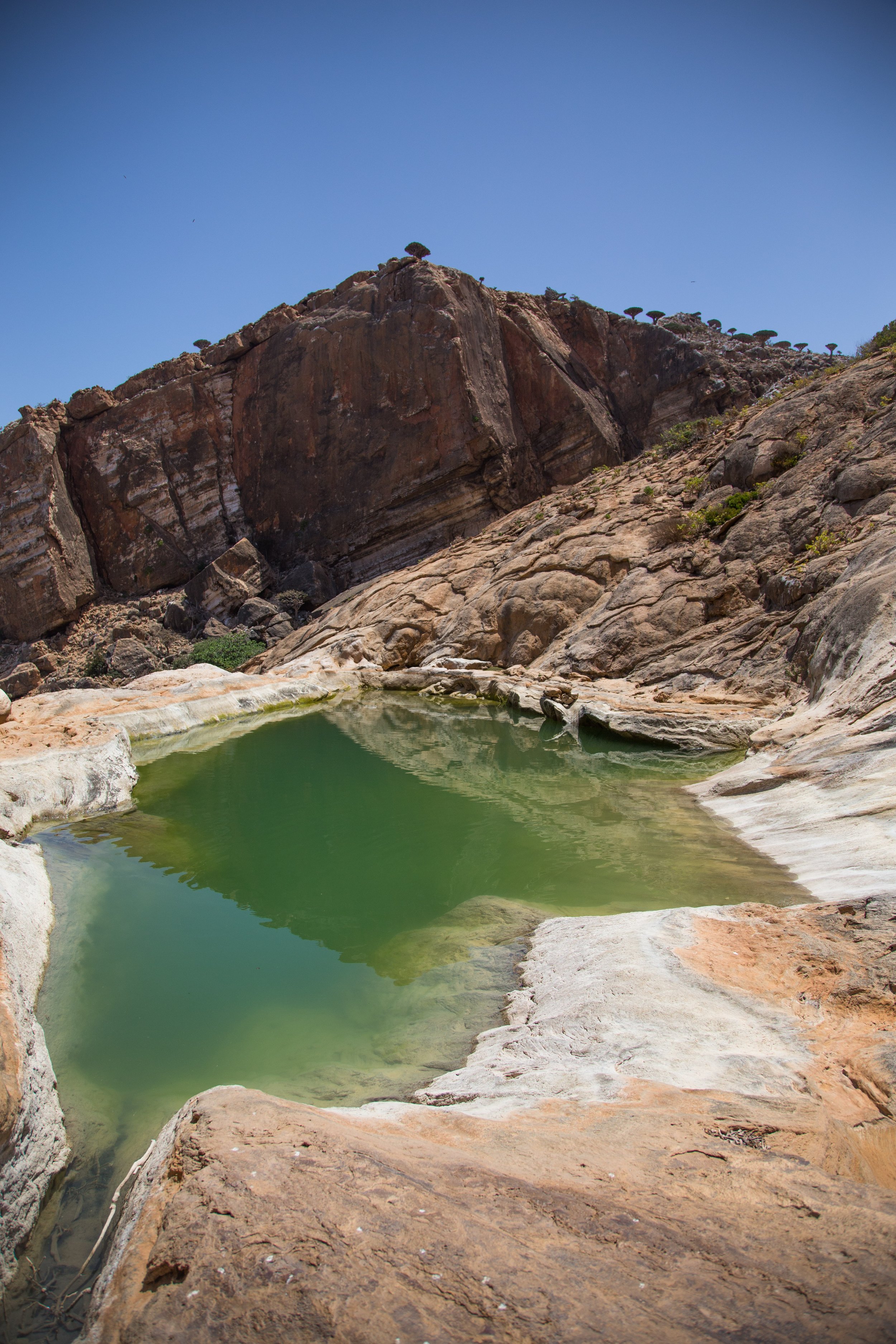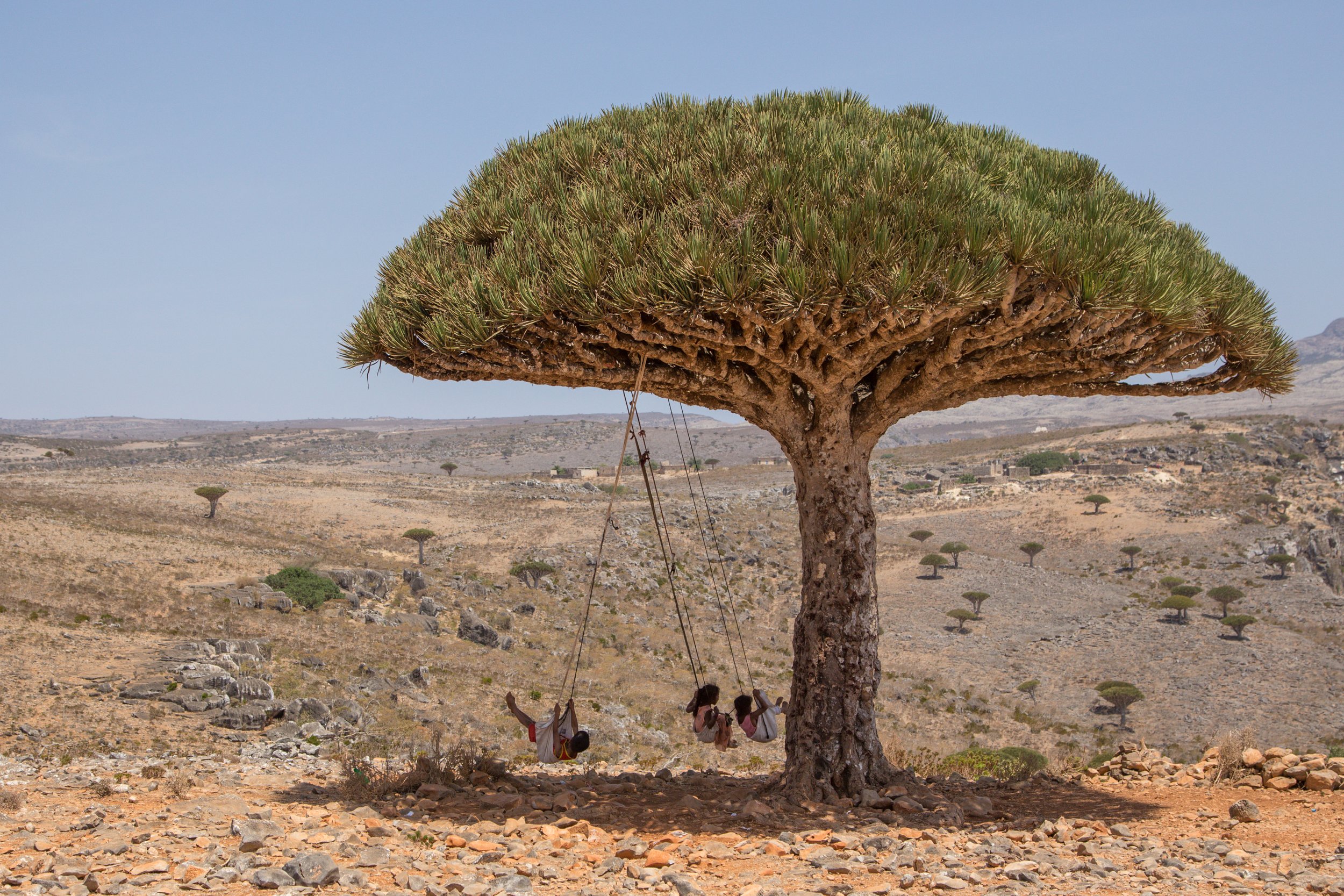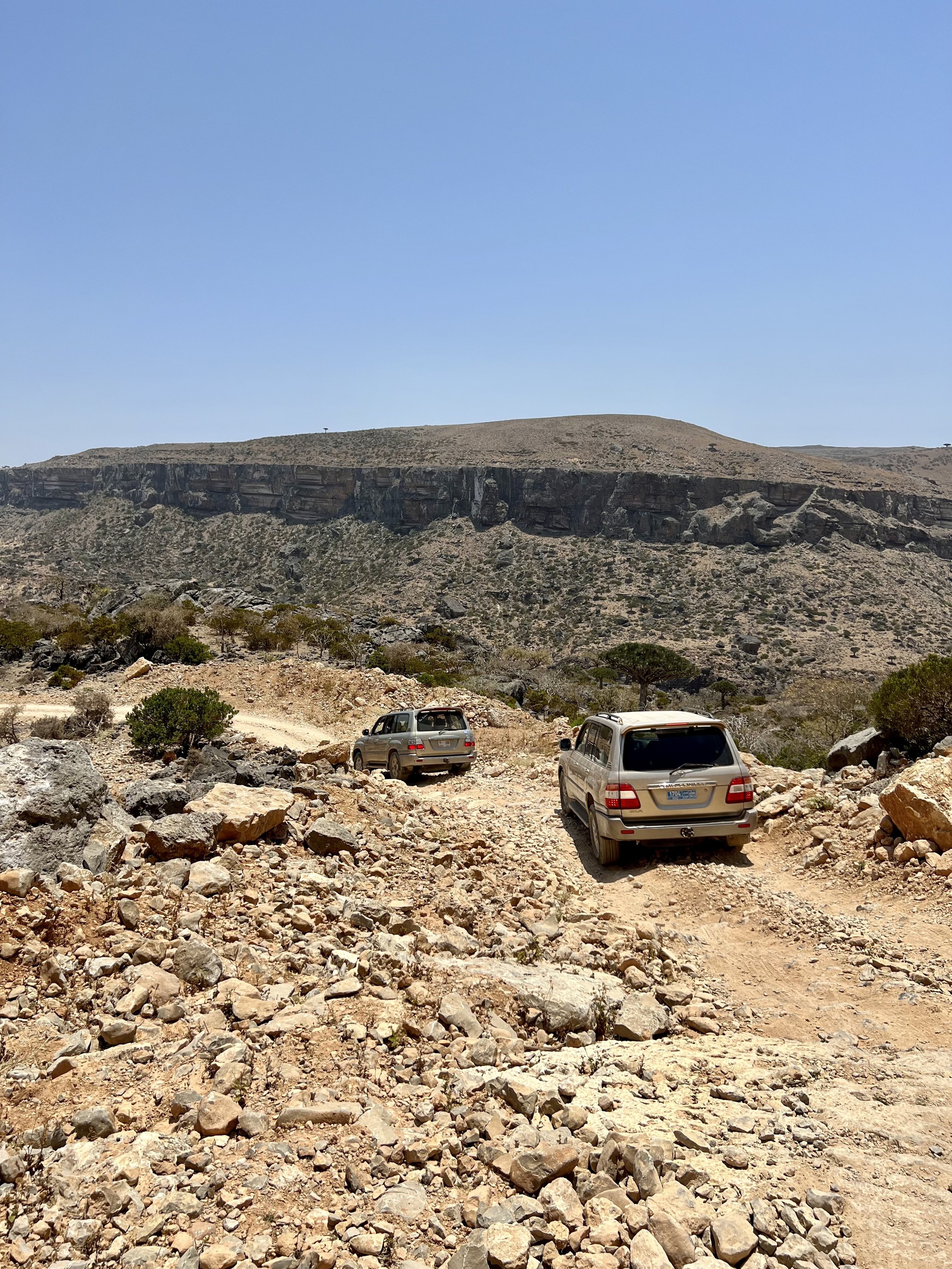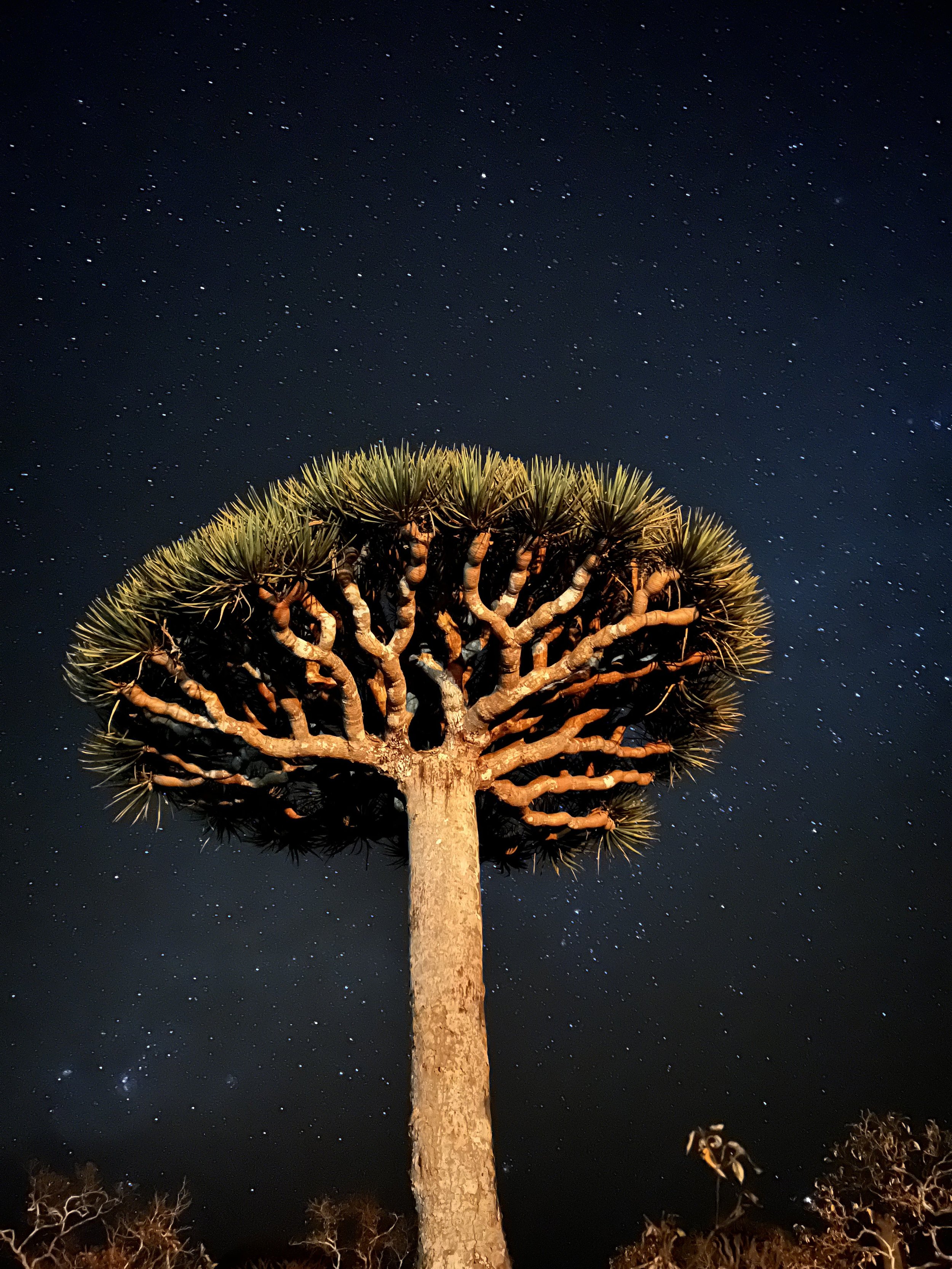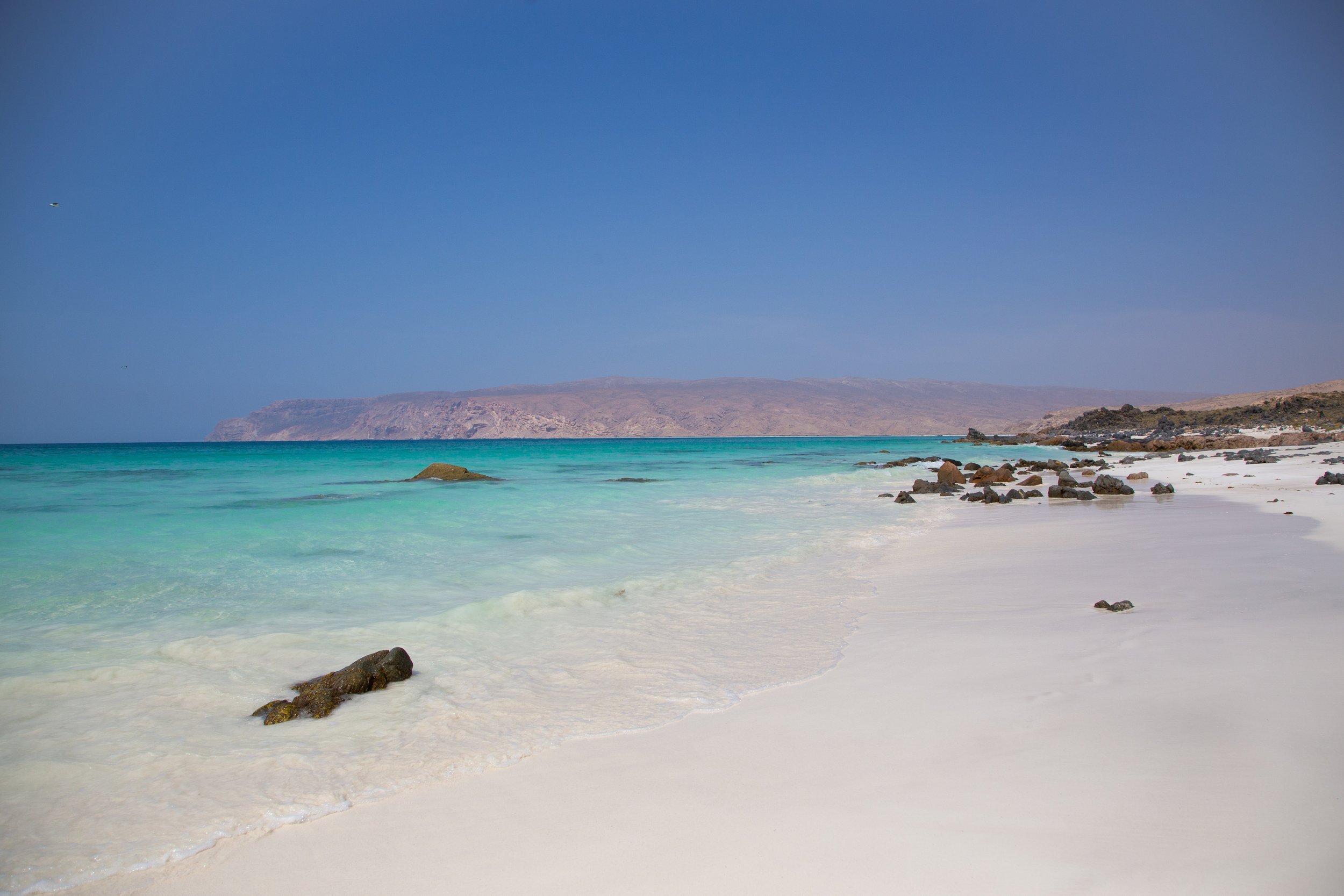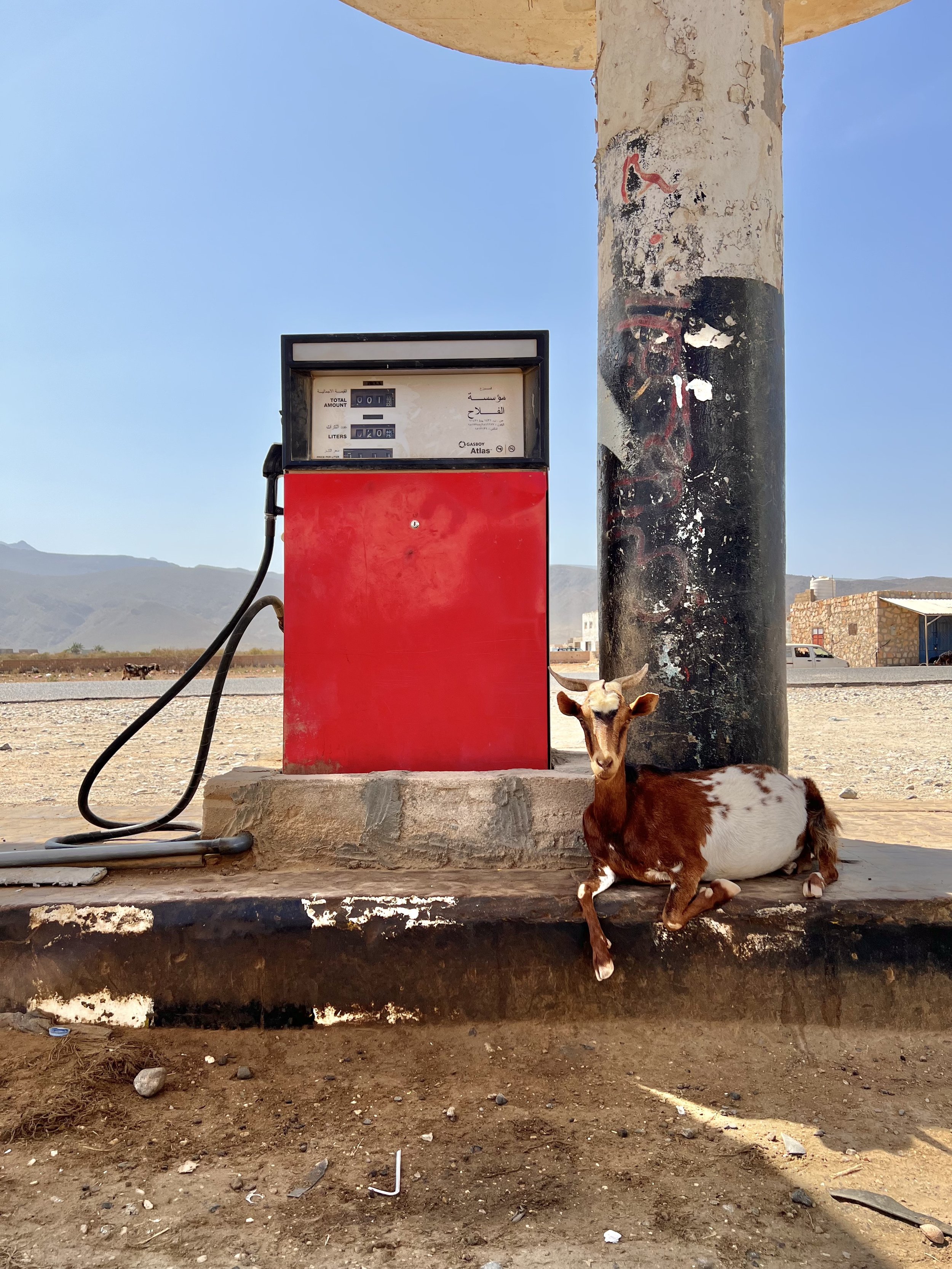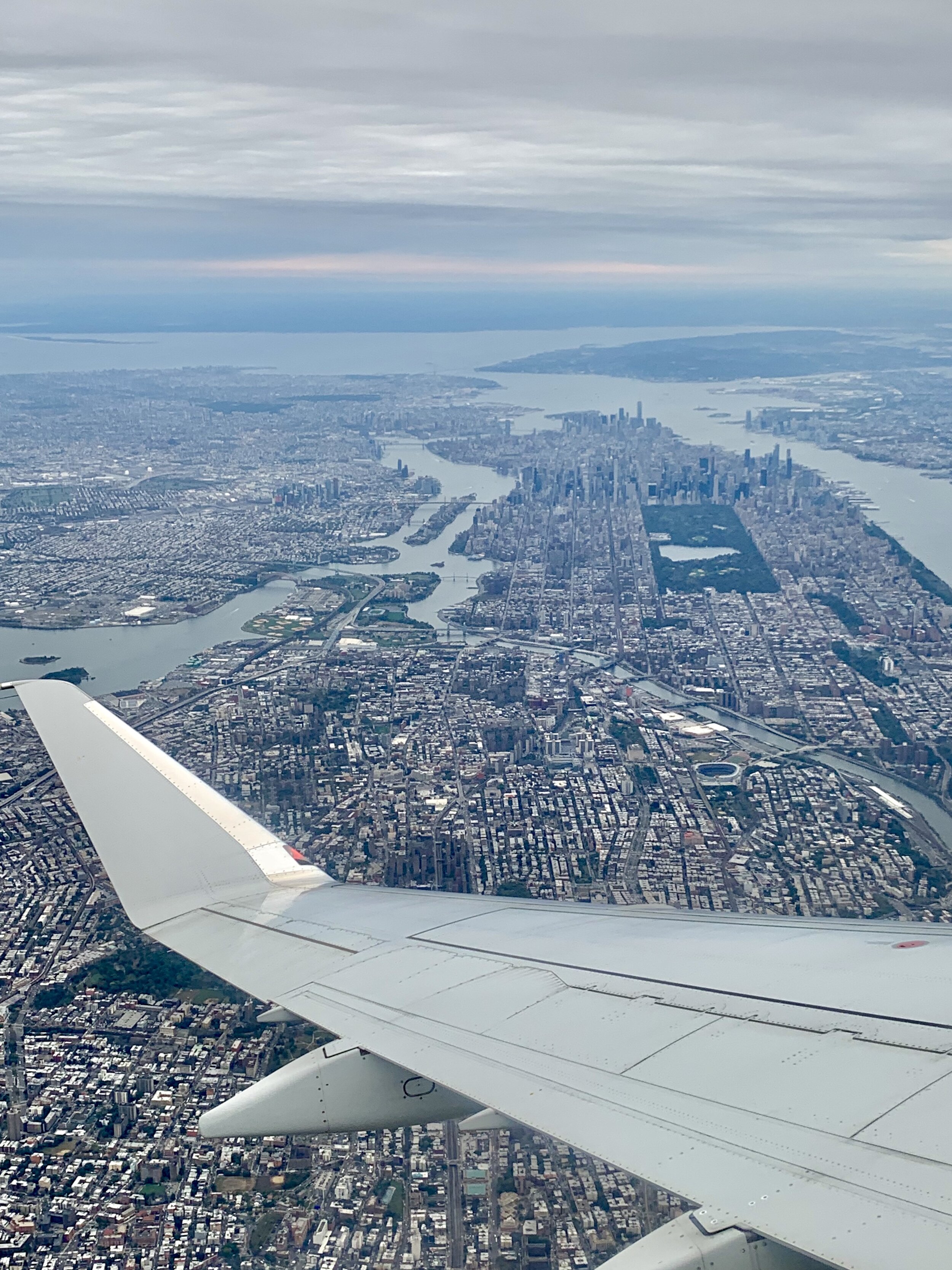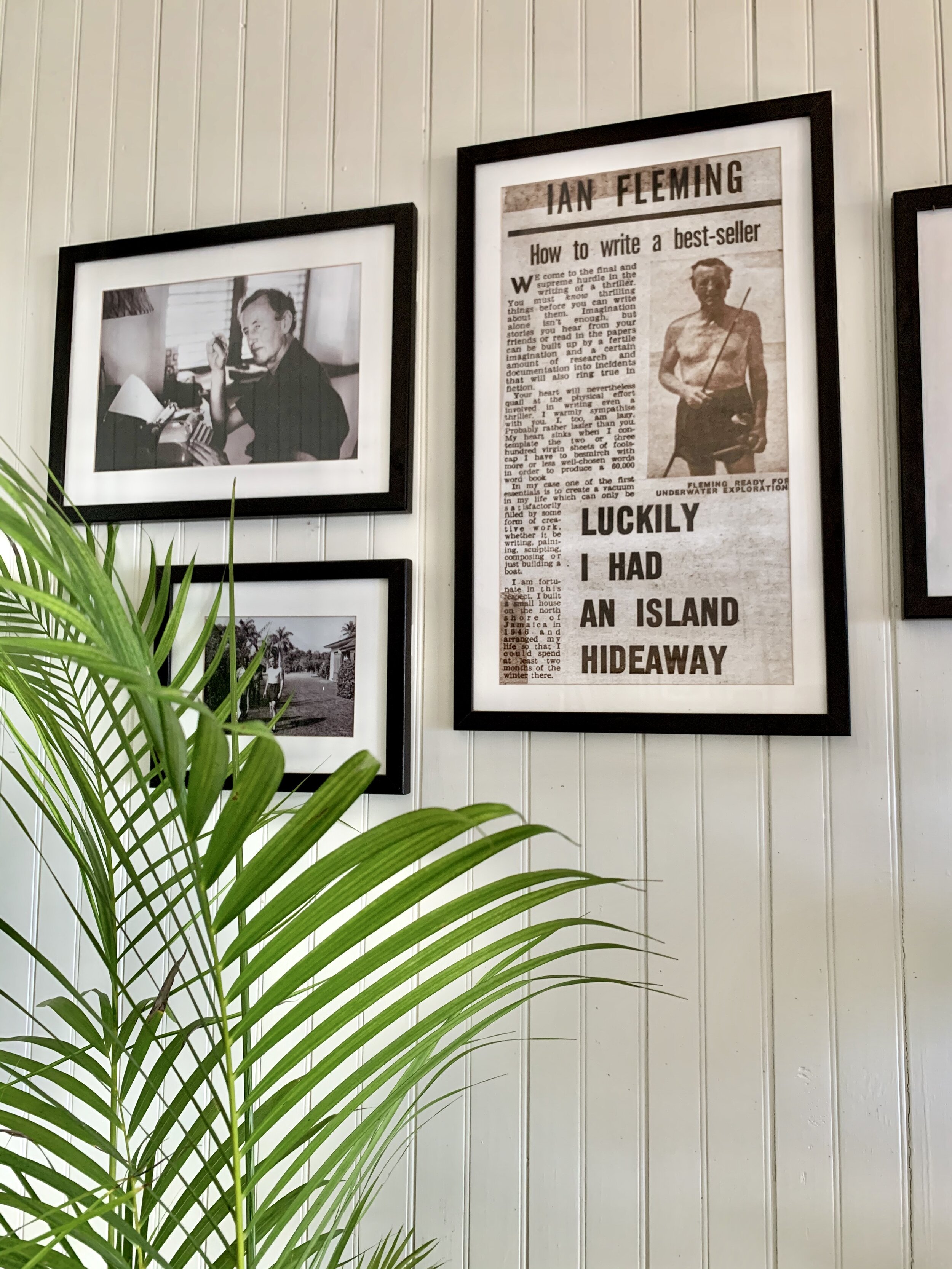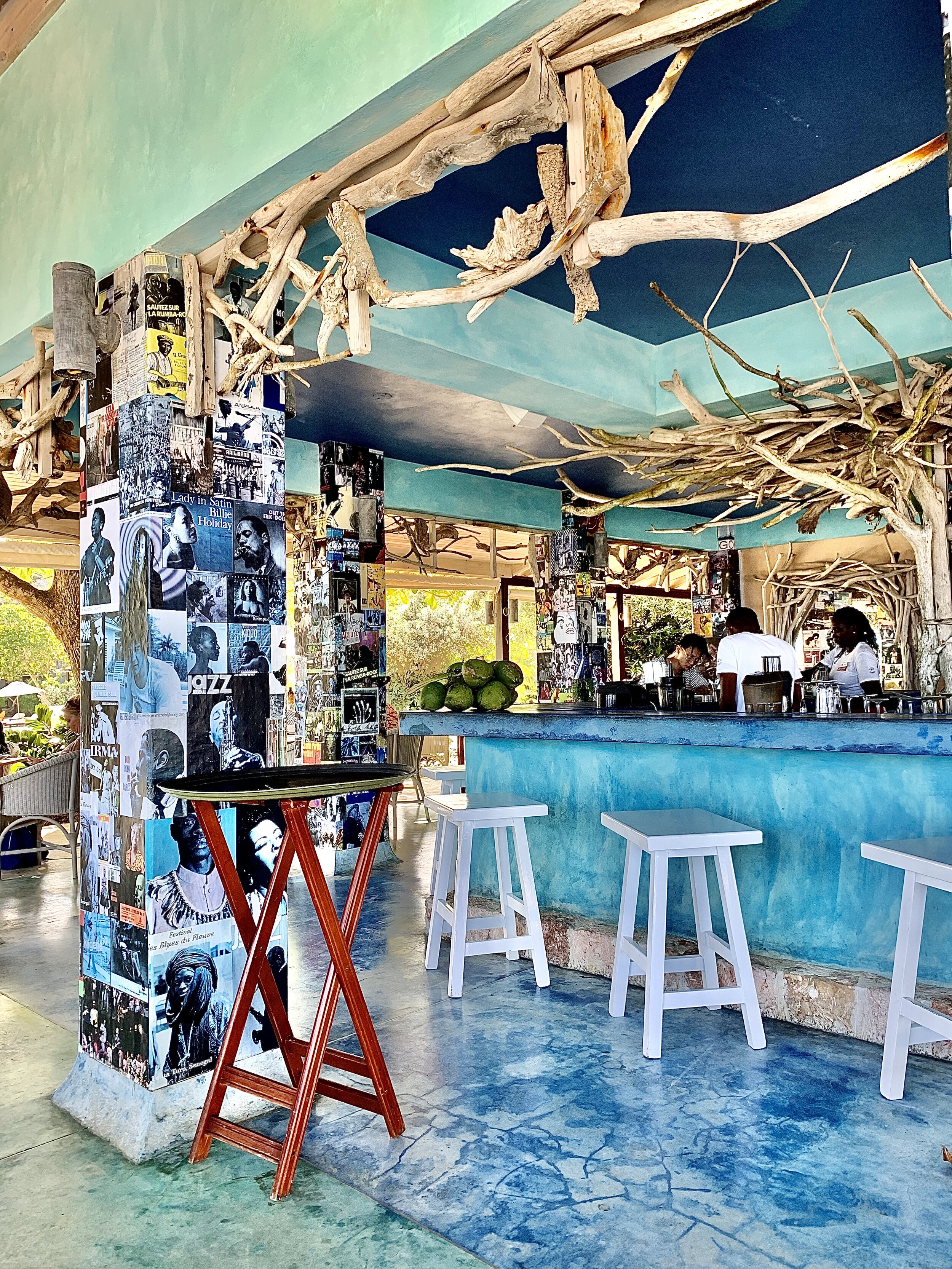I remember reading about the remote island of Socotra, Yemen, as a young girl. Known as the Galapagos of the Middle East, with nearly 40% of its plants and trees found nowhere else on the planet, Socotra seemed almost unreal. Isolated from the mainland over 6 million years ago, its endemic species resemble something out of a science fiction novel - dragon blood trees (so named for their red sap), bottle trees, and the elusive Socotran chameleon. This year, I decided to make my lifelong dream of visiting the island a reality.
Bottle nose tree, Socotra
Visiting Socotra takes some planning: there is just one flight a week, run as a charter flight via Air Arabia out of Abu Dhabi. You cannot book the flight online; you’ll need to work with a tour operator to arrange it as well as your visa. I went with Piotr (Peter), founder of Pazola Travel, who has arranged multiple trips to the island over the years and seamlessly arranged this one. He is also one of the few operators to prominently feature scuba diving on multiple days of the trip; he is a long time instructor with over 8,000 dives under his belt. Our group of 8 met at the Abu Dhabi airport, having packed all of our scuba diving gear, sleeping bags and headlamps, and lightweight clothes for hiking and adventures in the heat. This is a trip for the adventure-minded: we typically spent the night camping or in relatively basic accommodations, and there are no frills (and very few items available for purchase) once you arrive on Socotra for the week.
Sunset at camp in Dihamri, Socotra
Upon arrival in Hadibo, the largest town on Socotra with a population of roughly 10,000, we were greeted by our guide, Abdularuf, and three drivers with their respective Toyota Land Cruisers, who would be with us for the week. We spent the first night at the Summerland motel, a popular and clean choice in town that even offers some basic breakfast and limited wifi. We headed out for lunch at the most popular restaurant in town, which served grilled fish, chicken, piping hot freshly made local flatbread, and an assortment of freshly squeezed juices (highly recommended).
Cooking local flatbread in Hadibo
Hadibo at night
Hadibo itself is relatively vibrant, with plenty of locals walking around (women dressed in black in full burqas and men in traditional local colorful dress), mingling with goats and scores of trash (there is no place to discard of trash on the island, and unfortunately most of it ends up on the streets). This is also a place of extreme poverty: most things that end up on the island must be imported, and this is not cheap (or affordable for most of the population living off the land). At the aforementioned restaurant, any food not consumed by paying customers was promptly carried off to an ever-present group of hungry people who didn’t have the means to pay for a meal. At many of the small villages we passed during our time on the island, we encountered groups of children and families subsisting on the bare minimum to survive. Socotra is truly a sobering place that reminds us of just how small and insignificant we all are.
We are the lucky ones, the ones able to sit back in the Land Cruisers and explore the length of this unique and stunningly beautiful place. Our first stop was the Dihamri marine reserve, the longest coral reef on Socotra, where we set up camp for the night and completed a checkout dive with the only local scuba instructor, Walid. The reef is in near pristine condition, a testament to what our planet might be like with sustainable fishing operations. We observed reef sharks, turtles, and thick forests of richly coloured hard and soft coral gardens. I saw no discernible coral bleaching, which I’ve sadly grown used to as the norm at most dive spots around the world. This is a real underwater paradise–and what’s more, equally amazing for divers as well as snorkelers, as many sites have a maximum depth of 30 ft (10m). After our second dive, we hiked among the nearby bottle trees and gazed into the depths of the Arabian Sea as the setting sun turned everything around us a rainbow of red.
Homhil, Socotra
Arher beach, Socotra
The next morning, we set off further east towards the landscape-dominating sand dunes of Arher. We detoured towards Homhil in the mountains in the interior, from where we hiked with a local guide through dragon’s blood trees and curved canyons shaped by centuries of water culminating in nearby pools overlooking the plateau below us blending into the sea. We trekked down the mountain towards the beach at Arher, where we enjoyed a late afternoon swim with dolphins and a myriad of fish in crystal clear waters. After a quick rinse in the nearby river, we set up camp for the night directly on the beach, falling asleep to the crashing waves. Waking up about an hour before dawn, we hiked up the cool dunes in darkness to enjoy from the top one of the most beautiful sunrises I’ve seen in my travels.
Sunrise from Arher sand dunes, Socotra
After descending for a light breakfast by our camp, we headed to the easternmost part of Socotra, the fishing village of Irsal, from where we dove a shipwreck covered in decades of reef growth: giant clams, mussels, and bits of hard coral. Afterwards, backtracking eastwards, we completed a second dive (my favourite of the trip) at Rosh. Diving below the surface, we encountered one of the most beautiful and pristine hard coral gardens I’ve ever seen, full of life: a pair of lobsters chasing each other around coral heads, abundant schools of butterflyfish, and a rich microcosm of tiny nudibranch, shrimp, and crabs.
Colourful fishing boats in the village of Irsal, Socotra
Children swinging from a dragon blood tree, Socotra
A path through the dragon blood trees in Dicksam, Socotra
Dragon blood trees in Dicksam, Socotra
We next ventured into the interior of Socotra, into the depths of Dicksam, reachable via an extremely rocky and long road full of switchbacks. We were rewarded by a sea of dragon’s blood trees stretching in every direction and some of the clearest night skies still largely untouched by human life (and light). We walked through the trees as afternoon turned to dusk turned to night, a showcase of stars complementing the ancient trees around us. The best places I’ve travelled to are the ones that remind you of your fleeting existence on this planet and the immensity and greatness of the world around us; they fill you with hope that despite our destructive tendencies, humans will find a way to live sustainably and coexist with the products of millions of years of evolution. Socotra is one of these places.
The road to Dicksam
Watching the sunset over dragon blood trees, Socotra
The endless night sky in Dicksam, Socotra
Our last two days on Socotra were spent in the far western stretches of the island, miles from other human beings on the beach of Shouab. The decades-old wreck of a large Qatari ship stretches just offshore, offering plentiful sightings of goliath groupers, schools of tang, and numerous sting rays. We spent two dives here; we could have done ten and that wouldn’t have been sufficient. The privilege of being able to dive in such a remote place was not lost on us, and we emerged from the sea feeling changed.
Pristine Shouab beach, Socotra
If you have even the inkling of a feeling to make your way to Socotra, go: this is a place lost in time, unlike any other on Earth. It doesn’t take long to fall into its rhythm, letting go of the business of the outside world, in favour of a more peaceful, simple existence. This is true paradise for those lucky enough to visit.
What to pack
Pack lightly, but bring essentials such as medications, a fully charged power bank (minimum 30000 mAh depending on the devices you are bringing), extra memory cards for your camera, etc. You’ll want to travel solely with soft-sided luggage (ideally duffel bags that can be both carried and wheeled). Leave your drone at home; there’s a high chance it will be confiscated by airport authorities in the UAE, where they are illegal.
Most operators will travel with local crew, including a guide, drivers, and chef. The food on our trip exceeded all expectations: a rotating cast of local chicken, freshly caught fish, and the ubiquitous goat, all prepared by our cook in the open air by our camp.
A friendly local on Socotra
If you intend on going with an operator who offers scuba diving, you’ll want to bring all of your own gear, as essentially none is available for rent on the island given there is a sole divemaster. Tanks and weights are of course available, but I recommend bringing an extra mask and ensuring your dive computer has a good working battery. Walid (the local scuba instructor) has a few other pieces of gear for rent, but given the remoteness of the island, the selection is limited and prices are steep.
Fun fact: There are three things you will see endless amounts of on Socotra: goats, pufferfish, and vultures.
Detwah lagoon, Socotra





